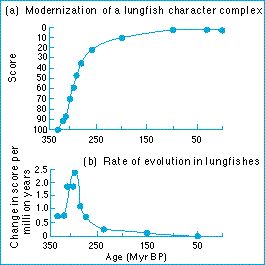Rates of evolution - How do we measure large changes?

A different method for measuring the rate of evolution
The measurement of evolutionary rates in darwins is appropriate for metrical changes, such as a character evolving to be longer or shorter; but for larger changes, such as from a leg to a wing, this method ceases to be useful. However, it is still possible to measure rates of evolution for larger changes.
Two main methods to measure rates of evolution for larger changes
Evolutionary rates can be studied quantitatively in characters whose evolutionary changes are not simply metrical. The characters can be divided into discrete states; the states assigned arbitrary scores; and the changes in those scores measured through time.
An example: lungfish
The classic example of this method was Westoll's investigation into lungfish, living fossils that have changed little from their fossil ancestors in the distant past.
Westoll distinguished 21 different characters of fossil Dipnoi. For each of the 21, he distinguished a number of character states. The 21 characters were awarded scores between 0 and 4 with the highest score being the most primitive condition and the lowest the most derived, and therefore advanced, state.
For each fossil, Westoll calculated a total score, made up of its total for all 21 characters. The most advanced possible lungfish, with 21 characters in the most advanced state, would therefore have a total score of zero.
The rate of change in the score measures the rate of evolution of the group. The numbers assigned to the characters states are arbitrary, but they can still be used to portray evolutionary rates.
Figure: evolution in lungfish: (a) shows the total score for each fossil. The rate of evolution is the slope of the graph: when the graph is flat, evolution is not happening. In (b) the rate of change of the score through time is shown.
| Next |



